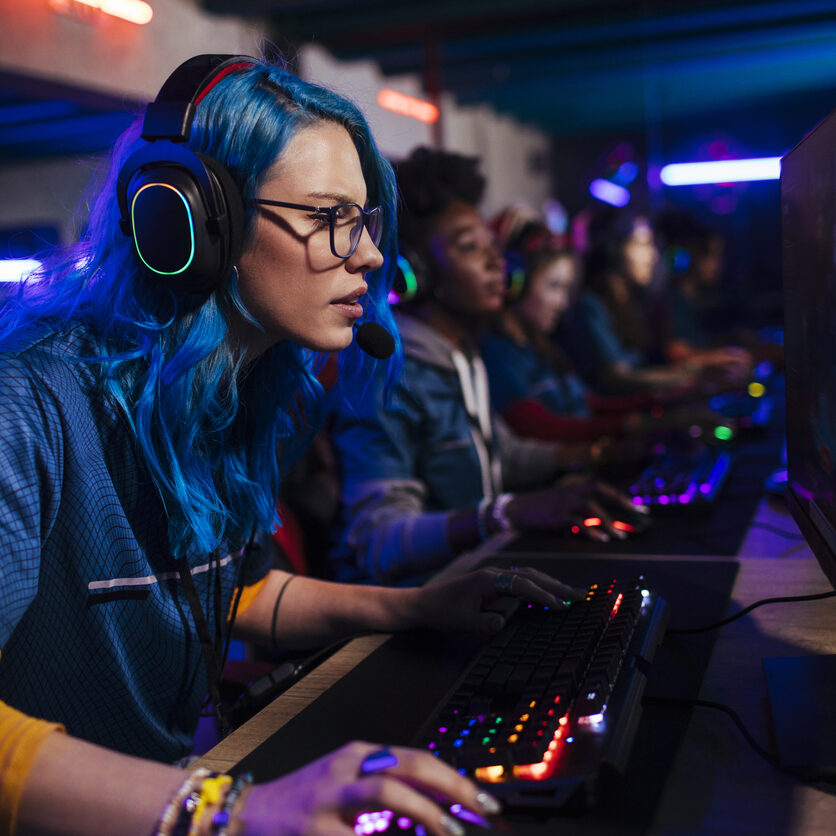
If you have a gamer in your life, whether it’s your own kid or a family friend’s child, you likely know how much video gaming is integrated into their lives. But even beyond the meteoric success and outright appeal of video gaming to young people (and even many not-so-young people), gaming now provides tangible benefits to serious players: competitive esports and esports college scholarships.
Parents of college-bound gamers might want to pay attention below, as we discuss college level esports and the burgeoning ecosystem of esports scholarships. And don’t forget that the high-speed fiber internet delivered to smart TVs and gaming devices by Northern Lights Fiber may just give the budding esports scholar in your life the edge he or she needs to own the competition!
Varsity Esports Are Exploding Across Colleges and Universities
Following the 2010s and the exponential growth of video gaming and esports, it’s obvious now that collegiate esports are truly taking off as a legitimate competitive endeavor. This explosive growth is mostly due to advancing internet technology like Northern Lights Fiber’s fiber network and apps that make gaming more social and more competitive, as well as increased talent among players. Indeed today, there are approximately 500 American colleges and universities offering esports scholarships.
Every year, more and more colleges and universities across Canada and the US add varsity esports programs to their rosters. And yes, we did say “varsity”—as in intercollegiate competition, not just a club or diversionary dorm room duel. Robert Morris University was the very first college to create a varsity esports team back in 2014—and the trend has only ballooned since then.
At the varsity and college level, schools typically create individual teams of players around particular games. This gives gamers the opportunity to advance and even excel at strategies and tactics suited to the complexities and skill needs of that title, enhancing the competitiveness of each game and of esports more generally.
Beyond enormously popular and well-known titles like Fortnite (played by untold millions of people around the world both casually and competitively), several other titles are most commonly played at varsity level esports in colleges and universities in North America. In particular, Call of Duty, League of Legends, Rocket League, Smash Bros, and Valorant are among the most frequently duked-out games in collegiate esports.
Other games are also increasingly popular, however. Overwatch is noted for its hero customization and intense fighting, requiring stout players and almost preternatural reaction skills to succeed. Additionally, Rainbow Six: Siege and its almost alchemical blend of gaming genres like strategy and tactical shooting has attracted legions of players to the game based around Tom Clancy’s novels. Both games are fielding more varsity teams and are increasingly seen at college level esports tournaments.
Collegiate Esports Give Rise to Generous Scholarship Opportunities
Because there are actual competitions and bragging rights to be bandied about, colleges are also competing for the best talent in esports. Thus, more schools are also providing scholarships for their best esports players. That means real dollars are increasingly available that the top gamers can put toward the costs of their higher education. Indeed, in 2017, Harrisburg University became the first college to offer full-rides to its leading esports competitors, including room and board!
Already, an estimated $16 million in college scholarships exist just for esports players—not a small sum for a sport that barely existed only a decade ago. And as collegiate esports continue to rise, we can expect more schools to establish varsity programs, as well as expand their existing esports teams, too.
All this burgeoning esports growth at the college level means that more scholarships—and even larger dollar amounts—are likely to be dedicated to esports gamers. Hence, for the truly talented and committed gamer, esports should be taken seriously, and gamers should consider taking steps to making themselves more competitive for esports scholarship opportunities.
The Esports Gender Divide
Despite the stunning growth in collegiate varsity esports, we hasten to note an important issue inside the gaming and esports community—the gender divide. Though females make up almost 50% of all video gamers (49% to be precise, according to one 2023 analysis), statistics show that men receive 90% of esports scholarships.
With patently lopsided statistics like that, the divide has not gone unnoticed. Arguments abound for this staggering disparity, but at least one likely reason for the imbalance is that most of the games more typically played by female gamers are less likely to be the games that comprise competitive varsity esports in colleges.
With that in mind, however, savvy female gamers with a keen interest in esports games that are played at the varsity collegiate level may want to be particularly on the lookout for scholarship opportunities that have too frequently landed in the hands of their male counterparts. Their unique backgrounds and talents may help give young women an edge over their compatriots in the coming years—and also help broaden and improve the sport as well.
To stay on top of the ever-changing and always-exciting esports scene, follow Northern Lights Fiber’s social pages. We’re confident that our high-speed fiber internet can improve any gamer’s experience and perhaps even help prepare them for competitive esports and the worlds of opportunity they open!
